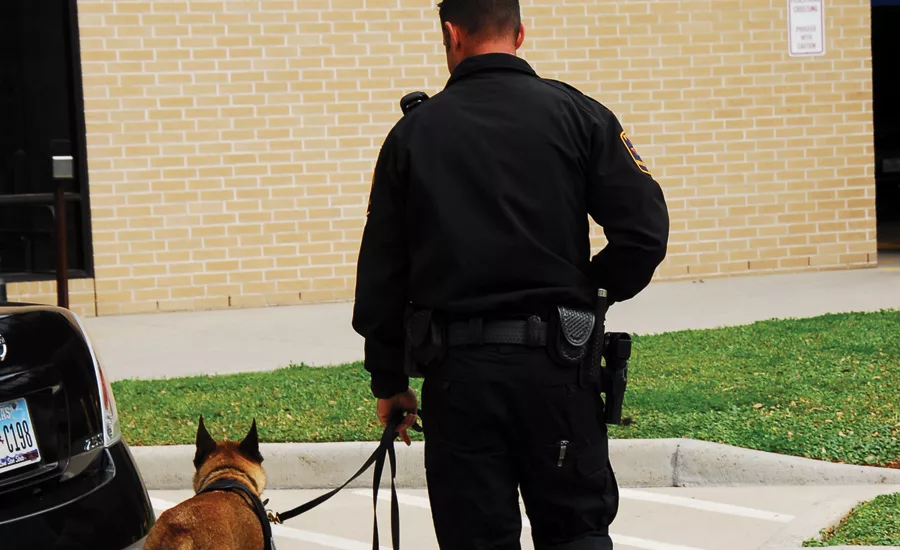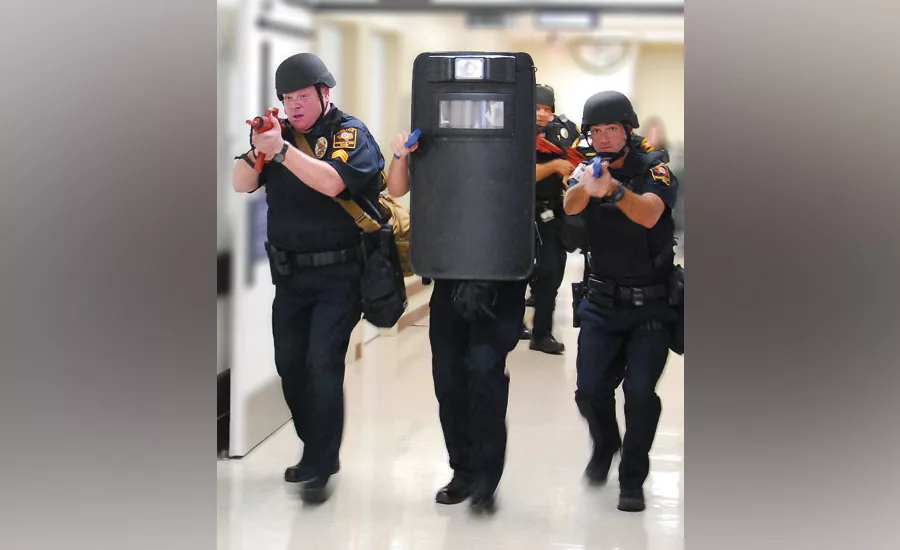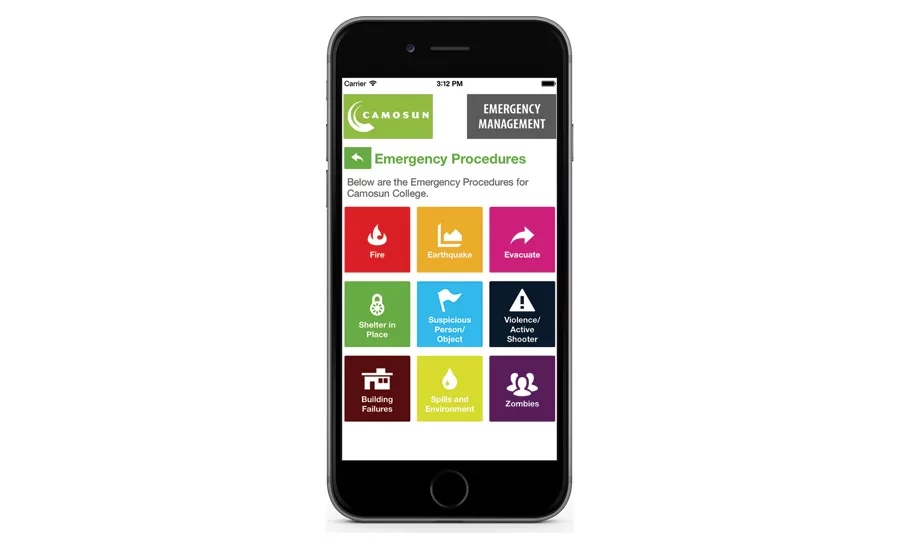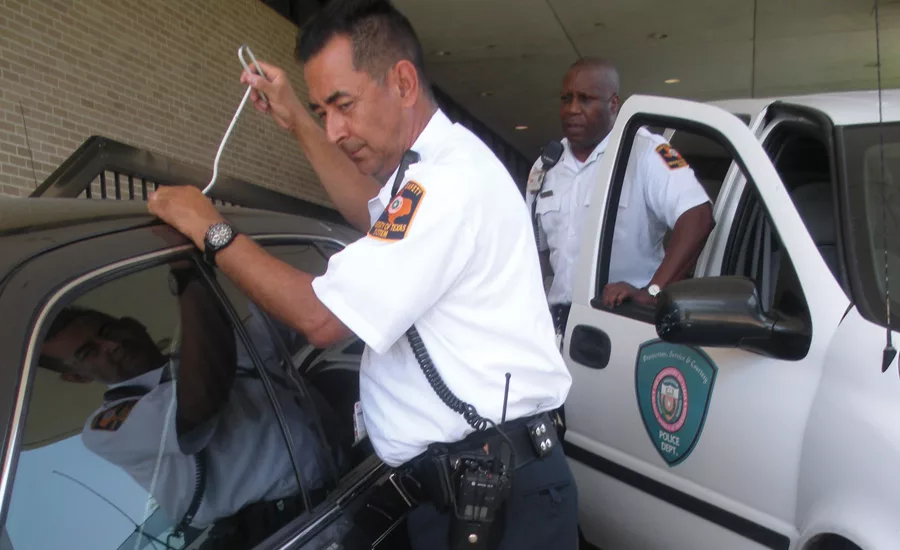Leading by Example: How Schools and Universities Are Staying Secure


Officer Braunsdorf and Canine Noey engage in a sweep for explosives in a stopped vehicle at University of Texas Medical Branch.
Photo courtesy of UTMB and Chief Thomas Engells

At the University of Texas Medical Branch, all police officers are trained on active threat response. This is the annual active shooter exercise in 2014 that took place within John Sealy Hospital. Pictured are Sergeant Noel Layer and Officer Wesley Braunsdorf and others performing as a contact team.
Photo courtesy of UTMB and Chief Thomas Engells

The phone application that Camosun Community College uses for emergency management is called AppArmor Mobile.
Photo courtesy of Chris Sinkinson, AppArmor Mobile

UTMB: Public Safety Officers Vinton and Canada are unlocking a car that was inaccessible to the owner at the University of Texas Medical Branch. This is one of several general services provided by the University Police, as well as battery assists, and after hours escorts.
Photo courtesy of UTMB and Chief Thomas Engells
As a student, feeling safe on campus, whether it’s elementary school, university, or somewhere in between, is imperative. With learning environments increasingly becoming targets of mass violence, there is increased responsibility on school security teams to make their campuses secure, yet welcoming and friendly. From security management plans to emergency notification systems to employing CPTED (Crime Prevention Through Environmental Design) throughout school property, there are a number of ways campuses can work to improve their security programs.
The Hard Data
The National Center for Education Statistics shows in its latest report that 65 percent of public schools recorded at least one violent incident in the 2013-2014 school year. That’s about 15 crimes per 1,000 students. This number was lower in elementary schools than in middle schools or high schools. Of those, 13 percent reported a serious violent incident such as rape, physical assault with or without a weapon, and robbery with or without a weapon.
The good news? These numbers have actually declined in the past two decades. The U.S. Department of Education also reports that criminal offenses on postsecondary campuses are steadily declining each year. In 2005, there were 84,483 reported criminal offenses, while in 2014, that number went down to 49,870. While securing school campuses is fraught with challenges, these statistics show that security departments are on the right path.
Utilizing Existing Resources
Margate City School District in Margate City, New Jersey, has developed a highly integrated emergency notification system using existing components, allowing them to keep costs low, yet significantly improving the school district’s lockdown process. The New Jersey Department of Education has been so impressed by the district’s lockdown program that Margate City is used as a model district, says Michael Morris, Technology Coordinator. “We wanted to design a system primarily using our existing equipment and systems that we already have in place and maintain to reduce costs and give us the highest amount of flexibility, compatibility and function,” Morris says: “a system that we could expand as needed, and one that required minimal training, as much of the system is already in place and people know how to use it.”
Morris and Kurtis Woodrow, Facilities Director at Margate City School District, documented their plans and implementations thoroughly, since they designed and developed everything themselves. “It’s really just the interface between the larger components, which are your standard phone systems, standard PA system, standard burglar panel, standard card access system, and then we’ve just made some integrations in between them to get them to do things during the lockdown,” says Woodrow.
These “things” include components such as the ability to enable a lockdown from any phone in the school; text-to speech messages that come across the PA and phones; automated calls and emails to the administration and first responders, alerting them that the district is in lockdown; interior doors automatically closing and only allowing first responders access; and messages popping up on all the district computers and Smart Boards.
The results have been impressive, and the district’s security team wants to get the word out that schools can do at least some level of automation with what they already have. “All these systems are systems that every school has readily available to them and already maintained,” says Woodrow. “You’re not bringing in a third party of equipment and a system that now everybody has to be trained on and get familiar with, and now you’re paying maintenance fees, service fees, yearly costs on something new that is an additional cost both on service and manpower to manage, maintain and get trained on. The systems that we use were systems we already maintain and manage.”
Partnerships With Local Law Enforcement
All the school officials we talked to stressed the importance of partnering with local law enforcement and first responders. “We work closely with our local law enforcement agencies,” says Byron Loucks, Manager of Campus Security at Camosun Community College. “We sit as a member of our local intel group, which is made up of local and federal police agencies, where we share info back and forth with respect to intelligence.”
Cody Mulla, Security Manager at Texas A&M Health Science Center, says he works closely with the Round Rock Police Department. “We have a circle drive, and I reverted the mail delivery trucks out of the drive because of pedestrian safety,” Mulla says. Local police were also dispatched ahead of time when Mulla became aware that a protest was going to happen. “I got all the officers out here and gave them tours of where the setup areas were for the protesters, and they dedicated resources that day to stand by. From a safety standpoint, they’re very involved.”
The Margate City School District also has a close relationship with the local police department, which “patrols our buildings throughout the day, so their card access system is the same as ours,” says Woodrow. “The difference is that their cards work when we’re on lockdown, while others don’t. When no one else can access certain areas, they can.” Thanks to numerous tours of the school, the fire department is also very familiar with both schools’ floor plan. “They know which door to enter to get to the closest exterior door to the location of where the problem would be,” Morris says.
At the University of Texas Medical Branch in Galveston, the security team is part of the state’s Terrorism Task Force, as well as members of the Homeland Security Fusion Center and the Houston Fusion Center. “We also have a partnership with the Galveston Police Department, which is here on the island,” says Thomas Engells, Chief of Police at UTMB. “We have a K-9 unit here that’s trained in explosive detection and tracking, so for example, when there are bomb threats at schools, we partner with our neighbors and help.”
Staff and Student Awareness and Education
Another key component of a good campus security program is educating staff and students. At Camosun College, this has taken an innovative form. “Last year, the marketing program was looking for ideas for students for projects, so we took the concept of marketing emergency management at the college to them,” Loucks says. “A group of them did a project on how to market emergency management to the college, and it worked out fantastically. All throughout the college we have security notice boards that we built all over the campus to bring awareness to the emergency management program. The ideas all came from the students.”
At Texas A&M Health Science Center, Mulla works hard on outreach to staff. He has started a quarterly newsletter and takes employees to “Lunch and Learns.” “It’s very key to get the community involved because you’re just increasing your eyes,” he says. “This also cuts down on complaints. You need to create those partnerships to let (staff) know that you’re here to make their job easier and safer instead of to enforce a rule that makes their life harder.”
Mulla also speaks at all new student orientations and started a community policing program. “Each officer has a dedicated area, and they spend 50 percent of their patrol time in that area basically getting real-time intelligence from students, visitors, or whomever,” he says. “You get them involved and looking around as well. It’s a great way to put the officer in a different role with the community.”
Fire and safety drills are run monthly at the Margate City schools and feedback is taken seriously. “Mike (Morris) puts together a survey after we do a drill to all the teachers and administrators to get their input on how the drill went, how things worked for them, volumes on phone, volumes on speakers, on the PA system,” says Woodrow. “We can get that back, review it, and make changes if necessary, or add speakers in areas if needed, or verify that some of the components are doing what we need them to do.”
Student education and awareness programs are plentiful at the University of Texas Medical Branch. “One of our popular programs is a rape aggression defense program,” Engells says. “The one restriction is you have to be a female to participate in this. It’s a program in which they teach them the fundamentals of defensive tactics and at the graduation; they actually get to go hands-on with an officer who is in a padded suit.”
Engells also does Lunch and Learns and has an aggressive active shooter education campaign. “We have a drill on campus every year. We let the students speak and we also broadcast training films like ‘Run. Hide. Fight’,” says Engells. “The most important aspect is situational awareness, knowing where you’re at. People have the tendency to be so focused on the task at hand, they only know the way they came in. I guarantee you: any large room has more than one way in or out.”
Vulnerability Assessments and Security Management Plans
Periodic assessments for potential vulnerabilities and an overall security management plan are essential to stay on top of security trends and keep students safe. “When I got here (in September 2015), I did a vulnerability site assessment, which included a three-mile radius,” Mulla says. “Basically a site vulnerability assessment explains the building use and common threats, and then lays out recommendations for mitigating risks. I do this from the outside in, looking at all security measures.” If security departments don’t have a five- to 10-year security plan, “when they go to update something that’s really old, it’s basically from scratch and all at once, so it’s a big, alarming number, as opposed to going from something from dirt and building it in a way where you can do it cheaper or more efficiently,” he says.
With two large campuses approximately 15 miles apart, having a master security plan is fundamental to smooth operations at Camosun College. “We’ve recently completed an audit of all security systems throughout both of our campuses. We discovered things that weren’t working and things that were supposed to be working,” says Loucks. “The biggest change we’ve made recently is going with an integrated system.”
Having buildings spread out all over the island involves many moving parts at the University of Texas Medical Branch. “I have a security master plan in which we address what we think are the fundamental aspects of how we’ll approach different issues on campus. We have a patrol plan that addressees how we patrol the campus, as well as the different areas that we have responsibility for,” Engells says. “For example, with the cameras we have a maintenance program where we replace cameras in a systematic fashion. We phase cameras based on the roles that they perform to ensure they have a greater reliability. I don’t want them all to collapse on the same day.”
Emergency Communication Systems
Schools need to be able to quickly communicate with first responders and with each other in the event of an emergency. “We have the ability for the police department to communicate into the building through the systems, through the pop-up messages on the Smart Boards and computers. Once that’s up and running, they can communicate into those classrooms and give an update to the staff and students, tell them to stay put, they’re still clearing the building,” says Woodrow. “Sometimes that can take hours if there’s a real problem before you can actually get people out of the classrooms, and they start to get a little fidgety and want to start popping their heads out the door. So, we tried to give another layer of communication to law enforcement to give some information to the people that are huddled in their corners to let them know what’s going on so they can kind of feel more at ease that things are happening and they weren’t forgotten about.”
The University of Texas Medical Branch uses an emergency notification system that has several options for staff and students to be notified, including text messages, phone calls, emails and Facebook and Twitter postings. “The institutional media is very responsive and will quickly broadcast alerts and notifications to our community,” Engells says. “Students, faculty and staff are listed by basic directory information into the system. If they wish to opt out of the notification network, they must file an opt-out form. They don’t receive messages all the time, and when they do receive a message, they know it’s something important.”
Mulla employs a similar emergency notification system at Texas A&M Health Science Center with an opt-out strategy. “Technology is always good,” says Mulla. “From my experience, most people are accustomed to having information at their fingertips and when providing services, I try to select strategies that are easy to use and provide the most up-to-date information.”
Onboard Training
When he was hired as Security Manager to help revamp the security department in 2015, Mulla realized that though the campus had all of the tools they needed to be secure, they weren’t utilizing them as well as they should. One of Mulla’s favorite tasks was developing an onboard training program for new officers. This felt particularly important, he says, because his officers are non-sworn. Modeled after the San Jose model that the regular police department uses, “I documented all the skills that they gained and what they either performed or demonstrated opposed to just saying that they understood,” Mulla says. “There are certain times when you’re training, especially when you don’t have that high activity level, you need to do the what-if situation and at least see that they get the idea if you don’t have a chance to perform it.”
Mulla is working on implementing verbal de-escalation training across campus as well. He sent an officer to get certified so he can bring the information back to everyone else. “It’s a train the trainer class, and it’s specifically made for law enforcement and health care, so I thought it was a good fit,” says Mulla. “With us being non-sworn, I’m trying to get the tools basically to be able to de-escalate a situation without force because that’s what your ultimate goal is – voluntary compliance. I plan to really plug it with the students because if you look at the trends in health care, which is where all these students are going, there’s a big issue with bullying in nursing. Then you have all the workplace violence and most of it is patient on employee, so I think (this training) has great application to help the students there as well.”
Crime Prevention Through Environmental Design
One way to both beautify and help strengthen the security program on any school campus is to employ the concept of CPTED. “Whenever I conduct a site vulnerability assessment, I include CPTED recommendations,” Mulla says. “CPTED is a great, cost-effective way to apply barriers at a site, paying close attention to lighting, foliage and other natural barriers. CPTED is one strategy that should always be in a security practitioner’s tool belt.”
“By design, CPTED strategies are intended to modify behavior in a positive way with the purpose of crime prevention,” says William Nesbitt, President of SMSI Inc. “There are no hard and fast rules or standards that you have to follow. Understanding the concept is the important thing with CPTED. It has a lot to do with better control of where we allow people to come in and what sort of screening process there is. There’s no guarantee that whatever you do is going to work, so in security we’re always working with probability.”
Basic CPTED principles schools can incorporate include:
• Maximizing visibility in all areas possible by making sure window areas are clear and foliage is cut down so areas such as entrances can be seen.
• Using landscaping and signs to direct people where they should go and keeping them out of places they shouldn’t. For instance, making sure exits and entrances are clearly marked and planting bushes or flowers to deter people from walking in certain areas.
• Creating a welcoming environment that also displays ownership. For example, hanging up banners or signs that emphasize school pride and/or displaying student work.
• Maintaining the campus well so that it’s pleasant and feels safe. This includes cleaning up trash or graffiti, changing light bulbs and repairing broken items.
• Considering switching to LED lighting. “It’s superior to any lighting that has come across the pike before,” says Nesbitt. “It’s bright white instead of yellow. It is really the only way to go to be efficient. It’s more expensive, but it saves energy and lasts longer. You get a lot less light trespass.”
Looking for a reprint of this article?
From high-res PDFs to custom plaques, order your copy today!







